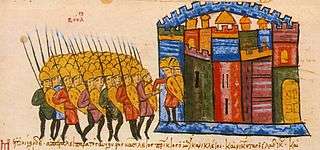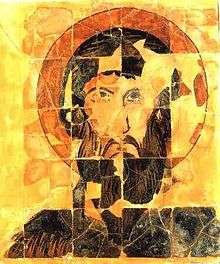Old Great Bulgaria
| Old Great Bulgaria | ||||||||||||||||
| ||||||||||||||||
 Old Great Bulgaria | ||||||||||||||||
| Capital | Phanagoria (632–665) | |||||||||||||||
| Languages | Bulgar | |||||||||||||||
| Religion | Paganism (Tengrism)[2] | |||||||||||||||
| Government | Absolute Monarchy | |||||||||||||||
| Khan | ||||||||||||||||
| • | 632–665 | Kubrat | ||||||||||||||
| • | 665–668 | Batbayan | ||||||||||||||
| Historical era | Middle Ages | |||||||||||||||
| • | Kubrat inherits the throne | 632[3] | ||||||||||||||
| • | Batbayan inherits the throne | 665 | ||||||||||||||
| • | Old Great Bulgaria is conquered by the Khazars | 668 | ||||||||||||||
| ||||||||||||||||
| Today part of | ||||||||||||||||
Old Great Bulgaria or Great Bulgaria (Byzantine Greek: Παλαιά Μεγάλη Βουλγαρία, Palaiá Megálē Voulgaría), also often known by the Latin names Magna Bulgaria[7]) and Patria Onoguria ("Onogur land"),[8] was a 7th Century state formed by the Bulgars and Onogurs on the western Pontic Steppe (modern southern Ukraine and south-west Russia).[9] Great Bulgaria was originally centred on Phanagoria, between the Dniester and lower Volga,[10] (in modern Krasnodar Krai, Russia).
In the mid-7th century, Great Bulgaria expanded west to include Avar territory and was centered in Poltava. During the late 7th century, however, an Avar-Slavic alliance in the west, and Khazars in the east, defeated the Bulgars and the Great Bulgaria disintegrated. Successor states included the First Bulgarian Empire and Volga Bulgaria.
Origins
The etymology of the ethnonym Bulgar is not completely understood and difficult to trace back earlier than the 4th century AD.[11][12] It is generally believed to derive from the Turkic verb bulğha (to "stir", "mix", "disturb", "confuse"),[13] possibly suggesting that other Turkic peoples regarded the Bulgars as a "mixed" people,[14] and/or "rebellious".[15][16][17][18][17][18]
Later Byzantine scholars implied that the Bulgars had previously been known as the Onogurs (Onoğur). Agathon wrote about the "nation of Onogur Bulğars", Nikephoros I stated that Kubrat was lord of the Onogundurs, Theophanes referred to them as Onogundur–Bulgars and Constantine VII remarked that the Bulgars formerly called themselves Onogundurs. Variations of the name include: Onoguri, Onoghuri, Onghur, Ongur, Onghuri, Onguri, Onogundur, Unogundur and Unokundur. There are several theories about the origin of the name Onogur. In some Turkic languages on means "10" and ğur "arrow"; and "ten arrows" a federation of ten tribes, i.e. the Western Turkic Khaganate. Within the Turkic languages, "z" sounds in the easternmost languages tend to have become "r" in the westernmost Turkic languages; therefore, the ethnonym Oghuz may be the source of Oghur; that is, on Oğur would mean "ten clans of Oghuz".
Establishment
Between 630 and 635, Khan Kubrat managed to unite the Bulgars, Onogurs with the tribes of Kutrigurs and Utigurs under a single rule, creating a powerful confederation which was referred to by the medieval authors in Western Europe as Old Great Bulgaria,[19] or Patria Onoguria. According to some scholars, it is more correctly called the Onogundur-Bulgar Empire.[20]
Some scholars assume that it stretched as far west as the Pannonian plain and included among its subjects some of the Pannonian Avars. It is presumed that his capital was the ancient city of Phanagoria on the Taman peninsula. Kubrat's grave was discovered in 1912 at Pereshchepina, Ukraine.[21]
Khan Kubrat
According to the Nominalia of the Bulgarian khans, Kubrat was from the royal clan Dulo and a rightful heir to the Bulgar throne.[22] H. Zotenberg (1883), while translating John Nikiu Chronicles from old-Ethiopian, intentionally replaced the name Qetrades to Kubrat. Since then, the historiography erroneously holds a misconception that Kubrat was raised and baptized by the Byzantine court, while the John’s character Qetrades has no real-life connection to the ruler of the Great Bulgaria Kubrat.[2][22]
Kubrat quickly managed to overthrow Avar domination, extending Onogur influence among the Bulgarians in Pannonia in what subsequently became known as Hungary. Ultimately however, although there is no evidence that the Utigurs were independent of the Onogurs until after Kubrat's empire disintegrated, it is believed he seceded from the Onogurs when they became entangled in dynastic wars. After Kubrat's burial in Mala Pereshchepina, the Khazars, who had triumphed in the collapse of Onoguria, subjugated Kubrat's eldest son and heir Batbayan, forcing his other sons to flee north up the Volga (2nd son Kotrag) and west into the Balkans (4th son Kuber & 3rd son Asparukh) and Italy (5th son Alcek, Alzek) [23]
Disintegration
The events that unfolded following Kubrat's death are described by the Byzantine Patriarch Nicephorus I.[19] In the times of Emperor Constantine IV, he narrates, Kubrat died and Batbayan, the eldest of his five sons, was left in charge of the state. Under strong Khazar pressure, Kubrat's other sons disregarded their father's advice to stay together in order to resist the enemies and soon departed, taking their own tribes.
Old Great Bulgaria disintegrated under Khazars pressure in 668.[24]
Aftermath

Some Bulgars remained in the former Onoguria, under the domination of the Khazars.
- Balkars
Some also believe that the present-day Balkars of the Caucasus are the descendants of the Batbayan horde even though they . and speak a Turkic language of the Kipchak type. But in most Turkic languages the sound "b" became "m".
- Volga Bulgars
After Kotrag, the leader of the Kutrigurs, took control on the western Steppe, Batbayan led the ... into the upper Volga-Ural region. There they established Volga Bulgaria, at the confluence of the Volga and Kama. As the Volga or Silver Bulgars (Bessermens), they converted voluntarily to Islam in the 9th century. They managed to preserve their national identity well into the 13th century, by repelling the first Mongol attacks in 1223. However, they were eventually subdued, their capital Bulgar city became one of major cities of the Golden Horde of the Mongols and the Bulgars mixed with the Tatars. The citizens of the modern Russian republics of Tatarstan and Chuvashia are considered to be descendants of those Bulgars.
- Bulgars in Vojvodina and Macedonia
Kuber ruled in Sirmium over a mixed group of peoples – Bulgars, Byzantine subjects, Slavs, Germanic tribes – as a vassal of the Avar khagan. After a revolt he led his people to Macedonia. There he had settled in the region of Keremisia and made an unsuccessful attempt to capture the city of Thessaloniki. After this, he disappears from history and his people were later consolidated into the Bulgarian Empire by Khan Krum.
- Bulgars in Italy
Other Bulgars, circa 662, led by their "Duke Alzeco" (Altsek) sought refuge from the Avars with the Lombards and requested land from the Lombard King Grimoald I of Benevento in exchange for military service "for an uncertain reason", initially staying near Ravenna and later moving further south. Grimoald sent Altzek and his followers to his son Romuald in Benevento and they were then granted by Romuald land northeast of Naples in the "spacious but up till that time deserted" towns of Sepino, Bovianum (Boiano), and Isernia, in the present-day region of Molise in the Apennines. Instead of the title "Duke" Altzek was granted the Lombard title of "Gastald". Paul the Deacon in his Historia Langobardorum writing after the year 787 says that in his time Bulgars still inhabited the area, and that even though they speak "Latin", "they have not forsaken the use of their own tongue".[25]
Excavations in the necropolis of Vicenne-Campochiaro near Boiano which dates from the 7th century, found among 130 burials that there were 13 human burials alongside horses along with artifacts of Germanic and Avar origin.[26][27][28] Horse burials are characteristic of Central Asian horse-nomads, and therefore these burials are clearly those of the Bulgar settlers of Molise and Campania.[29]
- First Bulgarian Empire
After the state disintegrated under Khazar attack in 668, Asparukh parted ways with his brothers and led some of the Bulgars to seek a secure home. He was followed by 30,000 to 50,000 Bulgars.[30]
After the Battle of Ongal Asparukh founded the First Bulgarian Empire, which was officially recognized as an independent state by the Byzantine Empire in 681.
See also
- First Bulgarian Empire
- Kingdom of Balhara
- Kutrigur
- List of Ukrainian rulers
- Mount Imeon
- Phanagoria
- Utigur
References
- ↑ Southeastern Europe in the Middle Ages, 500-1250, Florin Curta, Cambridge University Press, 2006, ISBN 0521815398, p. 78.
- 1 2 John of Nikiû, Chronicle
- ↑ Southeastern Europe in the Middle Ages, 500-1250, Florin Curta, Cambridge University Press, 2006, ISBN 0521815398, p. 78.
- ↑ Marshall Cavendish Corporation (2006). Peoples of Western Asia. p. 364.
- ↑ Bosworth, Clifford Edmund (2007). Historic Cities of the Islamic World. p. 280.
- ↑ Borrero, Mauricio (2009). Russia: A Reference Guide from the Renaissance to the Present. p. 162.
- ↑ Fiedler 2008, p. 152.
- ↑ (Agathius, Priscus Rhetor, Zacharias Rhetor, and Pseudo-Zecharias Rhetor)
- ↑ Leif Inge Ree Petersen (2013). Siege Warfare and Military Organization in the Successor States (400-800 AD. p. 112.
- ↑ Theophanes,Op. cit., p. 356-357
- ↑ Gurov, Dilian (March 2007). "The Origins of the Bulgars" (PDF). p. 3.
- ↑ Golden 1992, p. 103–104.
- ↑ Bowersock, Brown, Grabar 1999, p. 354.
- ↑ Maenchen-Helfen 1973, p. 384.
- ↑ Chen 2012, p. 97.
- ↑ Leif Inge Ree Petersen (2013). Siege Warfare and Military Organization in the Successor States (400-800 AD): Byzantium, the West and Islam. Brill. p. 369. ISBN 9789004254466.
- 1 2 Golden 1992, p. 104.
- 1 2 Golden 2011, p. 143.
- 1 2 Patriarch Nikephoros I of Constantinople, Historia syntomos, breviarium
- ↑ Zimonyi Istvan: "History of the Turkic speaking peoples in Europe before the Ottomans". (Uppsala University: Institute of Linguistics and Philology) (archived from the original on 2013-10-21)
- ↑ Rasho Rashev, Die Protobulgaren im 5.-7. Jahrhundert, Orbel, Sofia, 2005 (in Bulgarian, German summary)
- 1 2 Mingazov S. Kubrat - the Ruler of Great Bulgaria and Ketrades - character of John of Nikiu work - Kazan: Institute of History of Academy of Science of Republic of Tatarstan, 2012
- ↑ Mingazov S. The Heirs of Great Bulgaria in Western Europe// Philology and Culture. - 2012. - № 1 (27).- S. 201-207. .
- ↑ The Other Europe in the Middle ages: Avars, Bulgars, Khazars, and Cumans, Florin Curta, BRILL, 2008, ISBN 9004163891, p. 351.
- ↑ Diaconis, Paulus (787). Historia Langobardorum. Monte Cassino, Italy. Book V chapter 29.
- ↑ Genito, Bruno (2001). "Sepolture Con Cavallo Da Vicenne (Cb):" (PDF). I° Congresso Nazionale di Archeologia Medievale. Archived from the original (PDF) on June 2, 2006. Retrieved 2007-09-27.
- ↑ Belcastro, M. G.; Faccini F. (2001). "Anthropological and cultural features of a skeletal sample of horsemen from the medieval necropolis of Vicenne-Campochiaro (Molise, Italy)" (PDF). Collegium antropologicum. 25 (2): 387–401. Retrieved 2007-09-27.
- ↑ "Longobard necropolis of Campochiaro". Archived from the original on November 6, 2007. Retrieved 2007-09-27.
- ↑ Conte Miltenova, N. - I Bulgari di Gallo Matese - Prefazione e postfazione di Giuseppe Mario Tufarulo Passaporto Editore, Roma, 1993. - C.N.R.
- ↑ Васил Н. Златарски. История на Първото българско Царство. Епоха на хуно-българското надмощие с. 188.
External links
- Old Great Bulgaria - facts and sources
- BULGARS, Oxford Dictionary of Byzantium (1991), vol.1, p.338
- Ivan Mikulčić, Towns and castles in medieval Macedonia, Makedonska civilizacija, Skopje, 1996 (in Macedonian)
- The Bulgarians, Minnesota State University
.svg.png)





